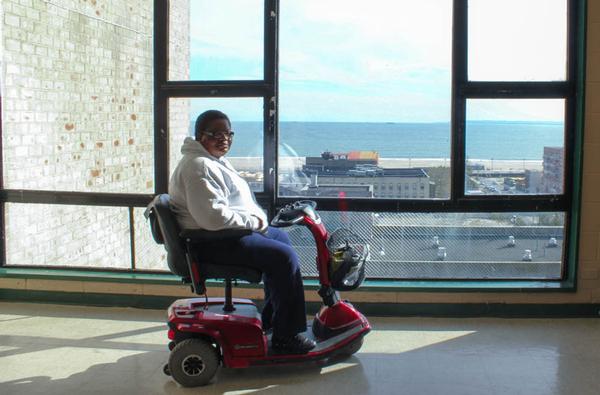
Photo by: Rahima Gumbo
Mabel James describes how rain from the storm crashed through the windows, flooding her apartment.
In a cubicle-like apartment with a 12th floor view of the Atlantic Ocean, the trauma of hurricane Sandy is still fresh.
“Water came through the window up to the chair. FEMA denied our case even though everything we owned was damaged,” says Mabel James, 56, a disabled grandmother of two, describing the after-effects of Hurricane Sandy last October and her ongoing attempts to claim financial aid from the Federal Emergency Management Agency.
James, a Nigerian-American who has lived in Coney Island for 25 years, describes how rain from the storm crashed through the windows, flooding her housing development apartment.
She is just one of the many low-income residents of this southern Brooklyn neighborhood dependent on government recovery assistance and coping with the long-term repercussions of the hurricane. Her experience stands in contrast to the upward economic recovery of Coney Island’s tourism industry.
Comeback contrasts
Millions of dollars worth of grants and loans from FEMA, New York City recovery programs such as Build it Back and private donors poured into Coney Island recovery efforts helping it bounce back from a disaster that affected over 5,000 small businesses and many more livelihoods.
Sandy wrought havoc along Coney Island’s commercial strip on Mermaid Avenue with many businesses suffering severe water and structural damage. Today 90 percent are back, with 10 to 12 businesses remaining closed for various reasons, according to a spokesperson for Astella Development Cooperation, a local non-profit focused on Coney Island’s commercial revitalization.
Yet residents like James, who live in housing developments on Surf Avenue and pull in a yearly median income of less than $27,000 according to the Census Bureau’s American Community Survey, wonder why they don’t feel the impact of recovery efforts.
“Last week a neighbor was telling me she only got one hour of hot water. Some people don’t have adequate electricity and some are living in shelters. People are still worrying about their basic needs,” says Regina Mitchell, a community advocate. “People are saying Coney Island is back, but [they] haven’t even talked to the people.”
“It is less a matter of basic needs, and more a problem of construction,” says Lisa Jones, director of Brooklyn Community Services’ relief and recovery program, who works on long-term case management of Coney Islanders impacted by the storm. She says many homes were still structurally damaged, in an area where a quarter of the community are low-income families. “There’s still a large need for services,” she adds, explaining that she could not quantify exact figures of residents lacking basic needs such as hot water and electricity.
Scope is hard to quantify
At a recent forum in Manhattan assessing community recovery, government officials, non-profit workers and researchers acknowledged the challenge of quantifying the human impact of the hurricane and keeping track of victims one year later.
“There are vague numbers. People don’t always check in. We don’t know exactly how many people were displaced and how many are back,” said Linda Gibbs, deputy Mayor for Health and Human Services.
The city has said that tens of thousands of people were displaced by the storm from hard-hit boroughs such as Brooklyn and Staten Island. An estimated 20,000 people from affected areas on the shorelines still remain displaced, living with family and friends because of damages to their homes, according to Gibbs.
Coney Island was second to the Rockaways in a survey presented by the Human Services council that showed where post-storm recovery and relief services were accessed. Case management and crisis counseling made up 60 percent of services provided to residents in Coney Island.
Debate over priorities
A block away from Mabel James’s apartment, where she lives with her daughter and two grandchildren, sits the Childs restaurant building, a 60,000-square-foot historic landmark whose terracotta archways have been at the center of a community debate on how local funds should be used.
The $50 million city funded plans to renovate the crumbling structure into an amphitheater and restaurant by the Brooklyn borough president Marty Markowitz, was denied by the local community board amid much criticism from the wider community. The community board decision is only advisory stage. Markowitz last week made his pitch for the project to the City Planning Commission.
Although the landmark has been a core part of the city’s rezoning and redevelopment plans approved since 2009, it has become contentious in light of the ongoing humanitarian needs of Coney Islanders after the hurricane, with some residents pointing to a recovery bias towards entertainment centers rather than human needs.
Residents and activists raised these concerns at a September community board meeting. Aida Leone, director of the Amethyst Women’s Project, a non-profit focused on Coney Islands women’s social needs, said there are more important areas the city allocated money should go to rather than the Child’s Restaurant.
“We want developments—like the renovation of the restaurant—to help the whole of Coney Island, not just the entertainment centers,” said Rhonda Brown Moore, 53, a non-profit worker who lives on Neptune Avenue, a few blocks away from the Child Restaurant.
As plans for the amphitheater move forward, residents who said they are left out in the planning process continue to criticize the project.
Yet others in the community have a more positive outlook. “The development of the amphitheater will provide jobs for local residents and open further economic developments,” says Chuck Reichenthal, district manager of the community board, adding, “It’s been a long, hard recovery since hurricane Sandy and it’s still not over.”








